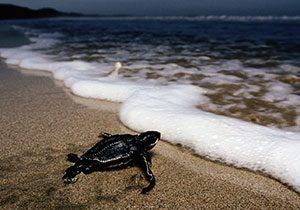
Eco Herb Garden Primary Resource
Get your fingers green with these home-grown, planet-friendly pots!
This primary resource gives children step-by-step instructions for making their owner eco-friendly herb pots.
Pupils will be shown how to make and decorate colourful pots for growing herbs (such as chives, coriander and basil), from a tin can, coloured paper, felt-tip pens, herb seeds, small stones and potting soil.
The teaching resource can be used as a printed handout for instruction in class time, or for display on the interactive whiteboard.
Activity: Ask children to complete the activity and make their own eco herb garden, either for their kitchen at home or to be displayed in the classroom. Encourage them to grow different kinds of herbs and be as creative as possible with their designs, using different colours and patterns. They could even experiment with different items and materials for decorating their pots (e.g. bottle tops, buttons, string, ribbon, glitter, beads, foil, paint, pastel etc)
N.B. The following information for mapping the resource documents to the school curriculum is specifically tailored to the English National Curriculum and Scottish Curriculum for Excellence. We are currently working to bring specifically tailored curriculum resource links for our other territories; including South Africa, Australia and New Zealand. If you have any queries about our upcoming curriculum resource links, please email: schools@ngkids.co.uk
This primary resource assists with teaching the following Key Stage 1 Art objectives from the National Curriculum:
Pupils should be taught:
- to use a range of materials creatively to design and make products
- to use drawing, painting and sculpture to develop and share their ideas, experiences and imagination
- to develop a wide range of art and design techniques in using colour, pattern, texture, line, shape, form and space
National Curriculum Key Stage 2 Art objectives:
Pupils should be taught:
- to improve their mastery of art and design techniques, including drawing, painting and sculpture with a range of materials [for example, pencil, charcoal, paint, clay]
This primary resource assists with teaching the following Key Stage 1 (Year 2) Science objectives from the National Curriculum:
Pupils should be taught to:
- observe and describe how seeds and bulbs grow into mature plants
- find out and describe how plants need water, light and a suitable temperature to grow and stay healthy.
- identify and compare the suitability of a variety of everyday materials, including wood, metal, plastic, glass, brick, rock, paper and cardboard for particular uses
- find out how the shapes of solid objects made from some materials can be changed by squashing, bending, twisting and stretching.
Lower Key Stage 2 (Year 3) Science objectives from the National Curriculum
Pupils should be taught to:
- explore the requirements of plants for life and growth (air, light, water, nutrients from soil, and room to grow) and how they vary from plant to plant
- investigate the way in which water is transported within plants
- recognise that soils are made from rocks and organic matter
This primary resource assists with teaching the following Expressive arts Early level objectives from the Scottish Curriculum for Excellence:
- I have the freedom to discover and choose ways to create images and objects using a variety of materials.
Scottish Curriculum for Excellence First level Expressive arts objectives:
- I have the opportunity to choose and explore a range of media and technologies to create images and objects, discovering their effects and suitability for specific tasks.
- I can create and present work using the visual elements of line, shape, form, colour, tone, pattern and texture.
Scottish Curriculum for Excellence Second level Expressive arts objectives:
- I have the opportunity to choose and explore an extended range of media and technologies to create images and objects, comparing and combining them for specific tasks.
- I can create and present work using the visual elements of line, shape, form, colour, tone, pattern and texture.
- I can create and present work that shows developing skill in using the visual elements and concepts.
This primary resource assists with teaching the following Science Early level objectives from the Scottish Curriculum for Excellence:
- I have helped to grow plants and can name their basic parts. I can talk about how they grow and what I need to do to look after them.
Scottish Curriculum for Excellence First level Science objectives:
- I can help to design experiments to find out what plants need in order to grow and develop. I can observe and record my findings and from what I have learned I can grow healthy plants in school.
Scottish Curriculum for Excellence Second level Science objectives:
- Through carrying out practical activities and investigations, I can show how plants have benefited society.
Scottish Curriculum for Excellence Fourth level Science objectives:
- I have propagated and grown plants using a variety of different methods. I can compare these methods and develop my understanding of their commercial use.
Download primary resource
More Like

Leatherback turtle facts!

Ocean facts!

Turn your lights out for Earth Hour!









LEAVE A COMMENT
THANK YOU
Your comment will be checked and approved shortly.
WELL DONE,
YOUR COMMENT
HAS BEEN ADDED!
COMMENTS
CUSTOMIZE YOUR AVATAR